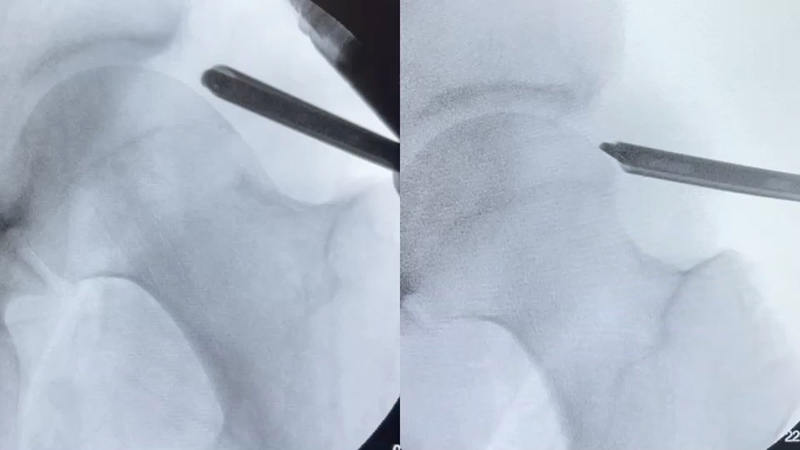Failed Hip Arthroscopy Treatment Options
Why may a prior hip arthroscopy fail?
A primary hip arthroscopy may be insufficient in alleviating pain and dysfunction, leading to persistent symptoms, functional limitations, or recurrence of pathology. Despite advancements in surgical techniques and technology, failed hip arthroscopy can occur due to various factors such as inadequate diagnosis, incomplete treatment of underlying pathology, technical errors during surgery, anatomical variations, or patient-related factors. Common reasons for failed hip arthroscopy include unresolved labral tears, residual femoroacetabular impingement (FAI), cartilage damage, hip instability, or complications such as infection or neurovascular injury. Management of failed hip arthroscopy may involve reassessment of the underlying pathology through imaging studies or diagnostic injections, revision arthroscopic surgery to address residual or recurrent lesions, or consideration of alternative treatment options such as open surgical procedures, hip preservation techniques, or conservative management.
What non-surgical treatment options are available?
Physical Therapy
Physical therapy following a failed hip arthroscopy plays a crucial role in addressing persistent symptoms, improving mobility, and restoring function. The therapy focuses on various aspects such as strengthening muscles around the hip, enhancing joint flexibility, and correcting movement patterns. Therapists employ tailored exercises, manual techniques, and modalities to address specific limitations and help patients regain confidence in using the hip joint. The goal of physical therapy after a failed hip arthroscopy is to enhance overall hip function, alleviate discomfort, and improve the patient’s quality of life.
Hip Injections
Hip injections can be considered as part of a comprehensive treatment plan following a failed hip arthroscopy, especially if there’s ongoing pain or limited mobility. These injections often involve the administration of corticosteroids or other medications directly into the hip joint or surrounding tissues to alleviate inflammation, reduce pain, and improve function. While they don’t address the underlying structural issues that might have led to the failed arthroscopy, injections can offer temporary relief, allowing patients to engage more effectively in physical therapy or other rehabilitative measures. Additionally, injections might serve as a diagnostic tool, helping to pinpoint the source of pain if there’s uncertainty about the cause.
What surgical treatment options are available?
Labral Re-Repair
Labral re-repair is a surgical procedure performed when a previously repaired labrum in the hip sustains a new tear or fails to heal properly. Dr. Shane J. Nho is able to suture the torn labrum back into place to help restore the stability of the hip and alleviate pain. Rehabilitation following labral re-repair is crucial, involving a structured program to gradually reintroduce movement and strengthen the hip while allowing the repaired tissue to heal optimally. Patient adherence to postoperative protocols is essential to support successful outcomes after labral re-repair for recurrent tears.
Cam resection
Femoroplasty is a surgical procedure utilized to address structural abnormalities in the hip joint, such as cam-type deformities, whereas an asphericity of the femoral head-neck junction (ball of the hip joint) leads to an incongruent fit into the acetabulum (socket of the hip joint). When a cam-type deformity is under-resected (meaning not adequately addressed during a previous surgery or treatment), it can cause ongoing issues like impingement, pain, and restricted hip movement. Femoroplasty involves precisely reshaping the femoral head or neck to correct the irregularities contributing to impingement. In cases where an under-resected cam deformity persists or causes continued symptoms, Dr. Shane J. Nho may perform femoroplasty to further sculpt the bone, aiming to alleviate impingement, improve joint mechanics, and restore smoother movement within the hip joint.


Labral Reconstruction
Labral reconstruction is a surgical procedure aimed at reconstructing a deficient labrum, a ring of tissue surrounding the hip socket that provides stability and cushioning to the joint. This procedure is typically performed when the labrum is severely damaged or torn to the point where it cannot be repaired. During labral reconstruction, Dr. Shane J. Nho most commonly uses grafts from donor tissue to reconstruct the irreparable labral tissue. Anchors are used to secure the graft in place of the native labrum, restoring stability and function to the hip joint
Capsular Reconstruction
Capsular reconstruction is a surgical procedure designed to address instability or laxity in the hip joint capsule. The hip capsule is a sturdy structure of connective tissue that surrounds the joint, providing stability and maintaining its integrity. When the capsule becomes stretched, torn, or unrepaired from prior surgery, it can lead to hip joint instability and discomfort. Capsular reconstruction involves tightening or reconstructing the capsule using various surgical techniques, such as suturing the existing capsule or using grafts to reinforce and restore its stability. Dr. Shane J. Nho performs this procedure to enhance joint stability, reduce pain, and regain proper function of the hip. Rehabilitation following capsular reconstruction is crucial to achieve optimal outcomes, often involving a tailored physical therapy program to regain strength, flexibility, and mobility in the hip joint.
Loose Body Removal
Loose body removal in revision hip arthroscopy involves the extraction of free-floating or dislodged fragments of cartilage, bone, or other tissues within the hip joint that may have developed following a previous hip arthroscopy or due to other factors like injury, wear, or unresolved issues. These loose bodies can cause pain, limited mobility, and potential damage to the joint if left untreated. During revision hip arthroscopy, Dr. Shane J. Nho aims to meticulously identify and remove these loose bodies, addressing any residual fragments that might be contributing to ongoing symptoms or impeding joint function. The procedure seeks to alleviate discomfort, restore smoother movement, and improve overall hip joint health by eliminating these loose fragments.
Dr. Shane J. Nho is a board-certified fellowship trained sports medicine orthopaedic surgeon who specializes in the treatment of prior failed hip arthroscopy procedures. If you believe you are affected by a prior failed hip arthroscopy procedure, schedule a consultation today with our experienced orthopaedic care team.
At a Glance
Dr. Shane Nho
- Board-certified, fellowship-trained orthopedic surgeon
- Team Physician for Chicago Bulls, White Sox, Steel
- Performs more than 700 procedures each year
- Learn more
